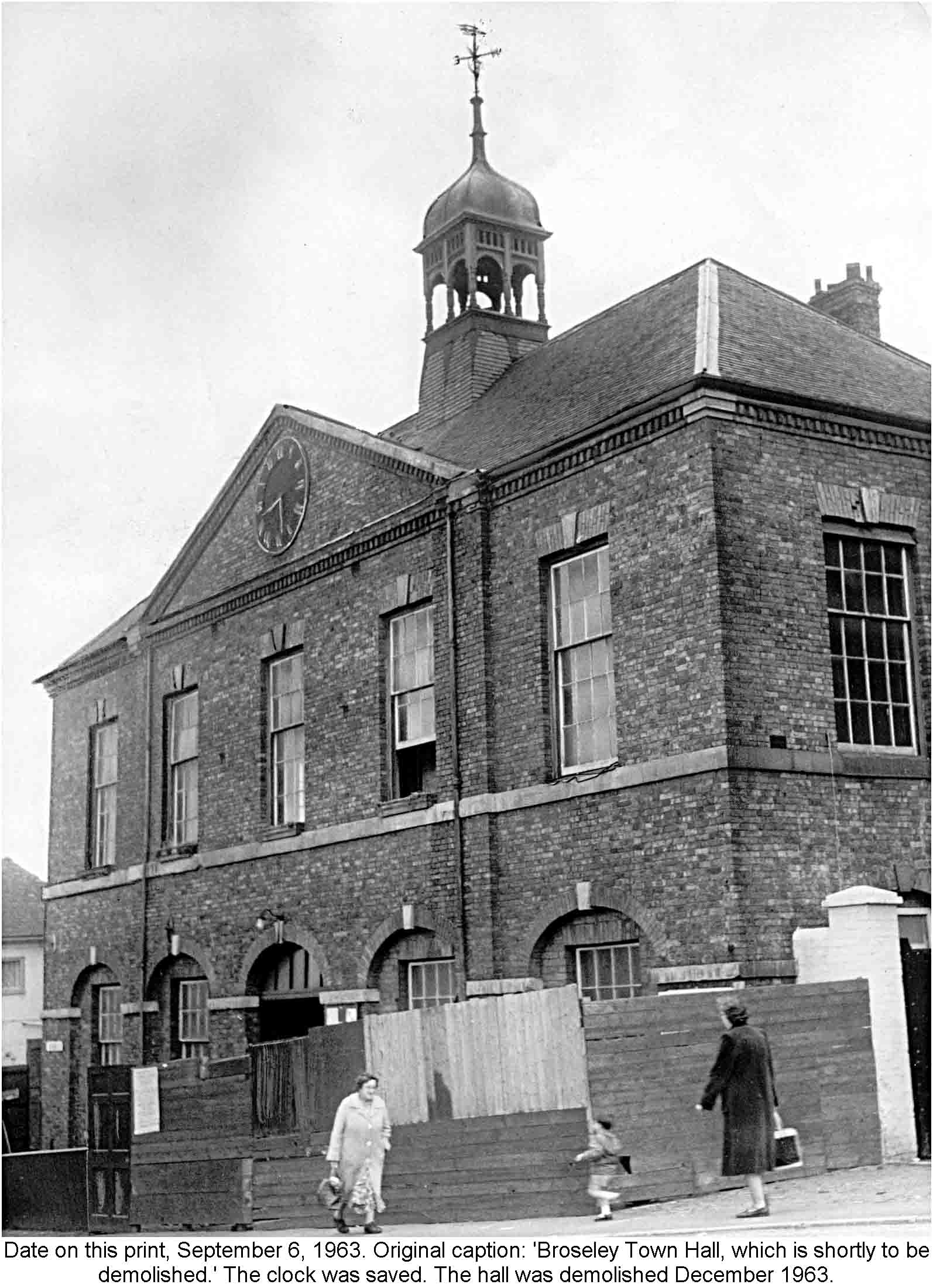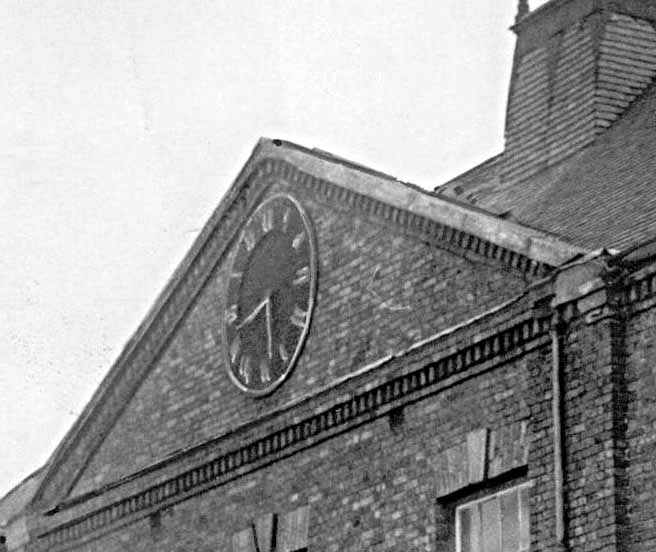Broseley Clockmakers
'The Clock and Watch Makers of Broseley'
Longcase Clocks and others
by Vin Callcut
An edited version was published in:
J. Broseley Local Hist. Soc. 2012 34, 22-28
The Blakeway Dynasty
The Hartshornes
Hinksman of Madeley and Broseley
Onions of Broseley
Reynolds
Census Returns
References
Directories
Acknowledgements
Letters 19/8/12 re Onions and Reynolds
There is little information published on the clockmakers who were living and working in Broseley during the late 18th and 19th centuries when clocks and watches were hand made by craftsmen. Their marked products may still occasionally be found and can make just an important contribution to the décor of a home as ever. Many horological books contain useful snippets of background information on makers but often they repeat the facts originally quoted elsewhere. The family names commonly found are Blakeway, Hartshorne (with or without the last ‘e’) and Onions but there are also others. It is sometimes said that a clockmaker living not too far away might have given the Broseley town name to a clock to suit local residents although he did not actually live here permanently.
The books of basic facts are those on clockmakers by Baillie (covering 1632-1825), Loomes (1825-1880) and Elliott (Shropshire Makers), see the references below. The trade directories of that time that have been seen to date do not give much useful information. They might now be usefully supplemented by the work of ancestry and census research. Any further available information will be welcome and added with acknowledgements.
Please send to 'vin (at) oldcopper.org' with the email address arranged in the usual format.
The Blakeway Dynasty
Each skilled clockmaker must have completed a long apprenticeship with a master and then either stayed with that business or moved elsewhere to meet a need for clocks. A good example of this is the Blakeway family.
Thomas Blakeway of Rushbury (1724-1805) was baptised 1724 and was brother to Charles Blakeway, clockmaker of Albrighton. He was a maker of turret clocks and examples are quoted made for churches in 1765, 1775, 1784 and 1794 and subsequent maintenance. He had a son, John, who continued the business in Rushbury and another, Thomas Blakeway who worked in Wenlock. The village of Rushbury lies in Apedale below the ridge of Wenlock Edge and near Acton Scott Working Farm. In 1796 Thomas married his cousin Priscilla who was the daughter of Charles Blakeway of Albrighton.
Charles Blakeway of Albrighton (1749-1809) clockmaker son of Thomas and Hannah Blakeway of Rushbury baptised 1749, brother to Thomas Blakeway, Jnr. of Rushbury. He married Elizabeth Barney of Albrighton in 1770 and had two children, both girls. A listing for a Charles Blakeway in Shifnal in 1789 probably covers the same individual. There was also aThomas Blakeway of Kinfare (aka Kinver), Staffordshire, near Stourbridge. Thomas Blakeway of Much Wenlock (1765-1795) was the son of Thomas and Ethelreda Blakeway of Rushbury and is mentioned as a clockmaker in 1789.
Thomas Blakeway of Broseley (Loomes 1836-1850) is a further development of the Blakeway family. The 1841 census return lists him as aged 65 so the dates given must be his working years and the British Museum records him as both clock and watchmaker with working years as 1776-1850 and based in High Street, Broseley. Clocks made by him do surface very occasionally.
In the Coach House of Delbury Hall, Diddlebury near Craven Arms, the original clock in the clock tower, made by Thomas Blakeway of Rushbury in 1753, still accurately chimes the hours.
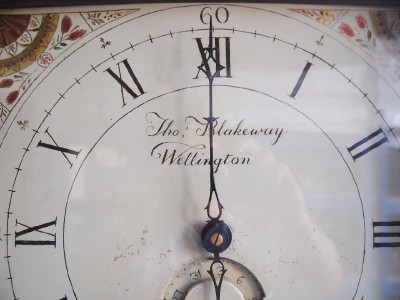
An 18th century longcase cottage clock by Thomas Blakeway with the town name of Wellington sold recently on eBay.
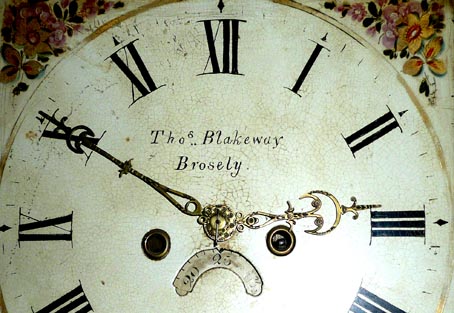
This is the face of an 8 day clock by Thomas Blakeway of Broseley that has probably been in the town ever since it was made.
The Hartshornes
The family name is said by some to have come from the village of Hartshorne in the Midlands but could surely have been assembled during past centuries anywhere that had a forest and deer. The name has certainly been around Broseley since Elizabethan times. The Hartshorne Village website records that: ‘The Hartshornes were a branch of the Derbyshire family taking their name from the unique Derby place name, they were long settled in Benthall, Salop and later at Broseley.’
An archived Bamford auction advertisement reads ‘Pocket watch by Thomas Hartshornewho was born at Polesworth 22nd July 1780, son of William Hartshorne and Dorothy Bolton, his wife who was a Polesworth girl. (Polesworth is at the northern tip of Warwickshire and is only four miles from Tamworth). He was apprenticed, probably to his father who was an Albrighton (Salop) watchmaker (working 1783-1794) and set up at Coleshill 1801. He married in 1810 and signed watches from both Coleshill and at Polesworth. There was a Richard Hartshorne working as a watch maker in Broseley 1782/1789 and a James making steel watch chains at Birmingham 1784-1791 both were probably close kin.’
William Hartshorne of Broseley was recorded as being apprenticed to a John Baddeley clock maker at Albrighton, Salop, 2nd February 1783 for 7 years at a premium of £12. Baillie records him as in Broseley 1793 as a watchmaker.
Loomes has three ‘Hartshornes’ listed for the later part of the 19th century but none in Broseley, only an Edmund in London 1869-81, Thomas in Coleshill 1835 and a William in London in 1875. When other adverts for long case clocks say the ‘style was influenced by Hartshorne’ it is not easy to know to which Hartshorne they are referring!
Baillie reports that a watch had been seen marked as made by William Hogshorne, presumably a spelling error somewhere.
On the 5th May 2011 an antique long case clock dating from 1800 - 1827 was sold unnoticed on eBay amongst the furniture. It had a painted dial with the name 'WILLIAM HARTSHORNE, BROSELEY' and an 8 day movement that chimed on the hour. A presentation plate on the inside of the door said "This clock was presented by the employees of the Madeley Wood Iron Company, Shropshire to Edward Smith and Mary Taylor on their marriage May 8th 1827."
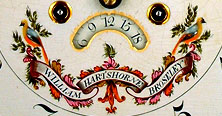
Another Hartshorne long case clock has just been sold from a dealers near Swindon. (Alan Smith)
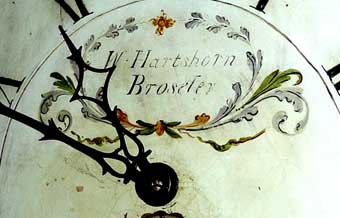
A clock by W Hartshorn (without the last 'e') can be seen (Nov 2011) on a website for sale in Canada. The 'W' can just be seen after years of use.
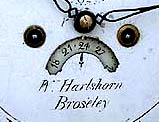 Recently a Hartshorn 30-hour long case clock was re-imported back to Shropshire after being fully restored in Poznan, Poland.
Recently a Hartshorn 30-hour long case clock was re-imported back to Shropshire after being fully restored in Poznan, Poland.
Another W. Hartshorn clock was advertised in February 2013 with the case said to be in poor condition. It appears to be an eight-day clock with moon face top to the dial and original hammered brass hands. The dial has Arabic numerals but interestingly 'Broseley' is spelt with the early 'f' type of font. It is now in new ownership and being restored. (Below, photos of face and details by Mark Turner)
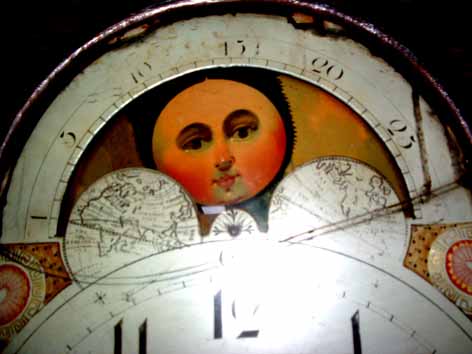

Below, this 'Brass-faced oak longcase clock by Richard Hartshorne has mahogany cross banding and checker line inlaid, the hood with broken swan neck pediment above fluted Corinthian columns, having a 13-inch broken arch brass dial, signed with Arabic and Roman chapter ring, seconds subsidiary dial and date aperture within foliate engraved spandrels, 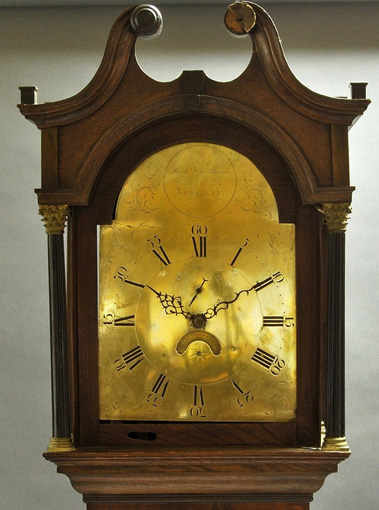 set 8-day anchor movement striking bell, the case with rectangular trunk door flanked by fluted Corinthian quarter pilasters, raised on box base with later plinth, 232cm high x 56cm wide (7'7" high x 22" wide). The maker's name is inscribed in the circle at the top of the dial.' It was sold at auction in April 2013 by Roseberry's of West Norwood.
set 8-day anchor movement striking bell, the case with rectangular trunk door flanked by fluted Corinthian quarter pilasters, raised on box base with later plinth, 232cm high x 56cm wide (7'7" high x 22" wide). The maker's name is inscribed in the circle at the top of the dial.' It was sold at auction in April 2013 by Roseberry's of West Norwood.
In the Broseley Local History Society newsletter for November 2007, Steve Dewhirst reported seeing on eBay a doctor’s watch that was made by William Hartshorne of Broseley around 1790. Still keeping reasonable time, it is a fine example 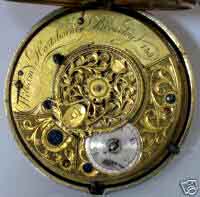 of a working doctor’s pair case watch. The watch has a sweep second hand and a stop slider enabling the doctor to take his patient’s pulse. Interestingly, it also has the name of a previous owner, B C Roberts Broseley, engraved on the inside along with the case maker’s mark.
of a working doctor’s pair case watch. The watch has a sweep second hand and a stop slider enabling the doctor to take his patient’s pulse. Interestingly, it also has the name of a previous owner, B C Roberts Broseley, engraved on the inside along with the case maker’s mark.
Hinksman of Madeley and Broseley
Loomes also lists an unknown ‘Hinksman’ in Madeley c1750. On the 28th April, 2008 , a mid to late 18th century oak 30 hour longcase clock with hour hand only by Hinksman with the town name of Broseley, was sold at the Royal Jersey 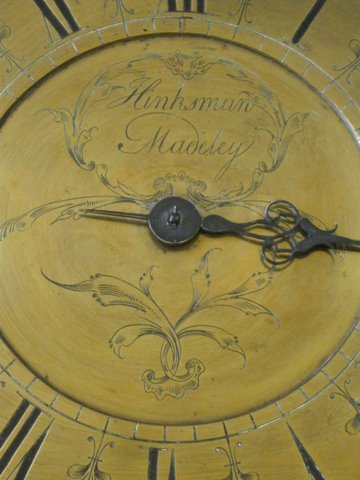
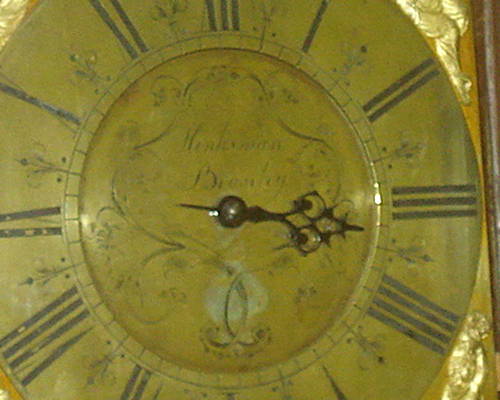 Showground in the Channel Islands. By an untraceable route through Wales it has now found its way back to a home in Broseley.
Showground in the Channel Islands. By an untraceable route through Wales it has now found its way back to a home in Broseley.
A very similar dial can be seen on a Hinksman clock from Madeley, the other side of the Iron Bridge over the River Severn from Broseley. It is now in the USA. There are also Hinksman clockmakers listed in nearby Bridgnorth. (L & G Auctioneers, USA)
Onions of Broseley
James Hurdley has records of a Peter Onions in Broseley c1760 and W. Onions in 1790. Baillie has no record for Broseley but has records the surname ‘Onion’ being used by a Thomas in London 1702, John Clarkson in London 1762, John in Stockport 1785 and a John in Manchester 1794-1800. Loomes lists a Peter Onions in Broseley c1760. Originally the Onions family owned an iron foundry in the centre of Brosely in a road now called 'Foundry Lane'.
W. Onions - A long case clock with face inscribed ‘Onions’ Broseley is dated 1790 is illustrated in ‘The Grandfather Clock’ by Ernest L. Edwards in 1971. Another is known in Broseley. It does not show an initial for a Christian name.
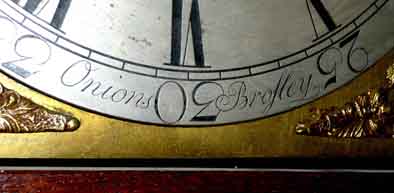
'The maker, W. Onions of Broseley, was a brother of a distinguished figure in the Shropshire iron trade of the last century - the late Mr. Thomas Onions of Stirchley. Their father, Peter Onions of Broseley, in conjunction with the father of the late Doctor Cranage, invented, as a smelter of iron at the ’Dale, a process of puddling, which, according to Mr. Randall, completely revolutionised the iron-making world. Mr. T. Onions died at Stirchley, May 1873, aged eighty-six. His brother, William, the presumed maker of the clock, was about four years his junior. Beginning life as a clock-maker, he eventually entered the detective service and was for some years resident in Paris. His later years were spent in Staffordshire, where he died some time in the Sixties.' (Miss) S. BARKER, Dawley. (Letter in Shropshire Star quoted in Broseley.org.uk website).
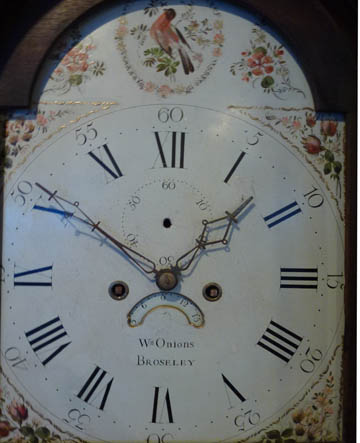 This is the face of a clock by William Onions of Broseley with a good painted face specially commissioned from the specialists at the Osborne Manufactory in Birmingham which opened a new warehouse in Colmore Row in 1770 (see Loomes). It has the two false winders and holes making it resemble an eight day clock but is fitted to a 30 hour movement that needs no key. This was a classic method for making a clock appear better. The second hand is missing at present.
This is the face of a clock by William Onions of Broseley with a good painted face specially commissioned from the specialists at the Osborne Manufactory in Birmingham which opened a new warehouse in Colmore Row in 1770 (see Loomes). It has the two false winders and holes making it resemble an eight day clock but is fitted to a 30 hour movement that needs no key. This was a classic method for making a clock appear better. The second hand is missing at present.
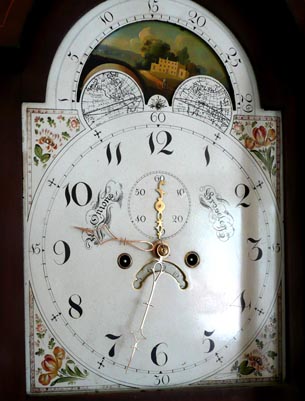
There is a recently restored 8-day long case clock by W. Onions in that is now nearby in Telford.
Reynolds
‘David Reynolds, clock and watchmaker of Broseley was charged in 1842 with feloniously stealing one screw spanner, value 5/-, the property of William Barker.’ – Shropshire Star. He is not listed by Loomes although the list does include 34 others with that surname elsewhere.
Census Returns
The 1801, 1811, 1821 and 1831 census returns were carried out by the ecclesiastical authorities and only recorded the very basic details of people, and these were mainly just naming householders with numbers in each house, sometimes divided up into males and females and in 1821 into age groupings. Some actually name all inhabitants and include extra details like relationships, occupations and ages. Only in Ireland in 1821 and 1831 were full details of all inhabitants required .in the rest of Britain, compilers, which were the overseers of the poor, teachers and clergy, were not instructed to give any names at all. Rough drafts of local returns were put into the local parish chest whilst the statistics only were sent to the census office.
Earlier forms of taxation can be classed as census returns in many respects. In 1694 a tax was introduced on births, marriages, burials, bachelors over 25 and childless widowers in England and Wales, this was after the Marriage Duties Act or marriage tax. It was repealed in 1705/6. Some of these early returns survive in full or in part, and depending on the county and diocese they can be inspected. The land Tax Assessments (1780 - 1825) are a very good way of locating the heads of house too. These should be in the local CRO. (County Records Office at Shrewsbury). (from: DotH Answerbank 23:31 Thu 29th Nov 2007)
At one time there was a fine turret clock on the Broseley town hall but the building was replaced with a supermarket.
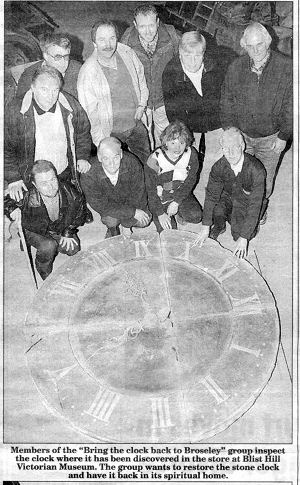
A movement is in store in the Coalbrookdale Museum warehouse that was said to from Broseley. However, this photo shows the clock with 'IV' for the number '4' whereas the one in the store has a stone face with 'IIII'.
References
G H Baillie ‘Watchmakers and Clockmakers of the World’, Vol 1, (1632 – 1825) N A G Press, London, 1929 with 25,000 names and reprints with an extra 10,000 ames,, ISBN 7198 0040 4
Brian Loomes ‘Watchmakers and Clockmakers of the World’, Vol 2 N A G Press, London, 1876 and reprints. (1825 – 1880 and later with a further 35,000 names)
Cecil Clutton, G H Baillie and C A Ilbert ‘Britten’s Old Clocks and Watches and their makers’ revised 1986 version of 1894 book originally by F J Britten (1843-1913) that has been revised, updated and expanded several times, being published by several organisations in the UK and USA including Spon (1956), Bonanza (1956), Eyre, Methuen / Spon 1973, Methuen 1975, and Bloomsbury in 1986. The original selection of 14,000 famous makers has been expanded to 25,000, 700pp, 130 references. ISBN 0 0906223 69 5. Excellent on clock and watch details and has a 300 page section restricted to covering only famous makers including Charles Blakeway of Albrighton but only four London ‘Hartshornes’, two ‘Onion’s and 33 various ‘Reynolds’ mostly in London.
Douglas J. Elliott, ‘Shropshire Clock and Watchmakers’ Phillimore & Co Ltd, London and Chichester, 1979. Hard cover book, ISBN 0 85033 328 8 with 172 pages including useful alphabetical list of 550 Shropshire clock and watchmakers from the early 16th to the late 19th centuries with 19 excellent black and white plates. This is a splendid detailed study of clock and watchmaking in Shropshire. Originally the book cost £7.95 but now it has been out of print for some time and has some rarity value in specialist shops.
'Broseley, A History of the County of Shropshire: Volume 10: Munslow Hundred (part), The Liberty and Borough of Wenlock (1998), pp. 257-293’. URL: http://www.british-history.ac.uk/report.aspx?compid=22876 Date accessed: 27 October 2011
Clock & Watchmaker Research Service (£5.99 per maker) - A Oldham & Son, Clock Repair Ltd, 22 Foot Wood Crescent, Shawclough, Rochdale, Lancs, OL12 6PB(mail@clockrepairrochdale.com)
British & Irish Clock and Watch Makers £4 per day for 50 page views
(http://www.clockswatches.com/showindex.php?em=B&page=3)
- Blakeway, Thomas of Broseley. This clockmaker or watchmaker has 1 trade directory entry listed on this site.
- Blakeway, John of Rushbury A brief document giving a single working date for John Blakeway of Rushbury.
- Blakeway, Thomas of Kinfare, Staffordshire. A brief document giving a single working date for Thomas Blakeway of Kinfare, Staffordshire.
- Hartshorn of Broseley, c1770 – no record
- Hinksman of Broseley – no record
- Onions of Broseley, c1780 – no record
Directories
Broseley Library has copies of the Broseley pages of many historic directories. Entry in these volumes was voluntary at the time and so the numbers present are obviously incomplete and there are scant references to clockmakers. The years present are listed as:-
1822 Piggot
1824 Gregory
1828 Tibnam
1829 Piggot
1835 Piggot
1840 Robson
1850 Slater
1856 Post Office
1859 Slaters
1861 Harrison Harrop
1863 Post Office
1879 Post Office
1871 Cassey
1874 Cassey
1877 Post Office
1879 Post Office
1885 Kelly
1891 Kelly
1900 Kelly
1903 Kelly
1905 Kelly
1909 Kelly
1916 Bennett
1917 Kelly
1922 Kelly
1926 Kelly
1929 Kelly
1934 Kelly
1941 Kelly
Acknowledgements
Many sincere thanks for help given by Broseley Library, Steve Dewhirst, James Hurdley, Melinda Evans and Miss M Gibbons of The Clock Shop in Bridgnorth Antiques Centre.
Letters 19/8/12 re Onions and Reynolds
On the subject of clockmakers, Jan Webb also wrote:
I was very interested in an article on the oldcopper.org website about Clock and Watchmakers of Broseley which says that a “David Reynolds, clock and watchmaker of Broseley, was charged in 1842 with feloniously stealing one screw spanner, value 5/-, the property of William Barker”. I should be interested to know where that information came from as David Reynolds was my great, great, great grandfather. From family research I knew he was a watchmaker and from criminal records that he possibly was the David Reynolds who was sentenced to three months’ imprisonment for the crime of larceny. Your article confirms this for me and has given me details of the case that I did not know before.
He appears in the 1841 census with his wife Susannah and children Bethuel and William, but says that he was not born in the county of Shropshire. Unfortunately the family do not seem to appear in the 1851 census which would have given me his birth county. By 1857 his wife Susannah has remarried and her marriage certificate says she is a widow. I have been unable to identify a death record for him so can only say that he died sometime between 1842 and 1857.
When his son Bethuel marries in the late 1800s he states that his father is unknown, not deceased. Maybe Bethuel genuinely did not know who his father was or perhaps he was ashamed of his father’s past. Bethuel was an honest, hard working chapel going man. I should love to read the article that the above comes from as it might just tell me a little more about him.
Jan Webb
Dear Jan,
I am very glad that the notes on clockmakers on the ‘oldcopper.org’ website have given rise to some interest and comment. That is just what is needed for us to be able the very brief histories given in the books on clockmakers. I would welcome more that identify the Broseley clockmakers better and perhaps tell us where they lived.
The quote regarding David Reynolds comes from p111 of ‘Shropshire Clock and Watchmakers; by Douglas J Elliott who quotes ‘Cal of Criminal Prisoners, 1 March 1842’. Incidentally the library copy of this book has vanished from their shelves. It seems that while specialist clock book shops recognise its rarity it is possible to scour Amazon and Abebooks to find a good second hand copy cheaper.
The history of the Onions family does remain unclear. The note regarding Peter Onions came from a letter to the Shropshire Star that is quoted on the ‘Broseley.org.uk’ website and cannot be further verified. It would be very interesting to know the links between ironmaking and clockmaking!
Best wishes,
Vin
A s t.
